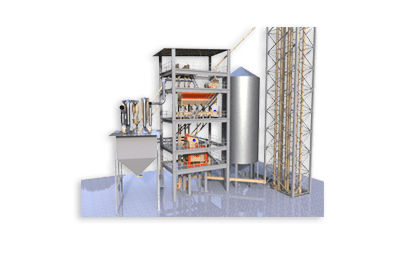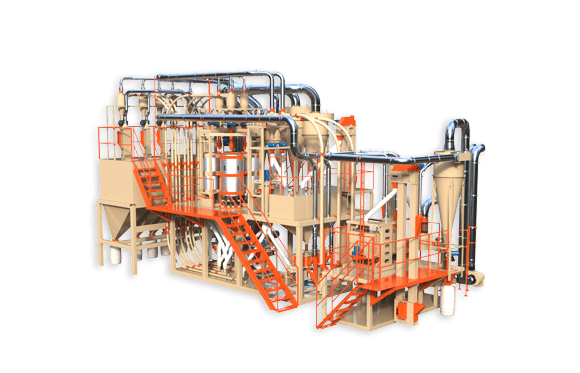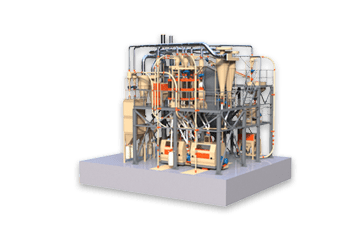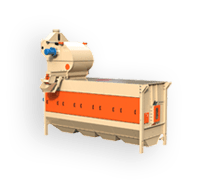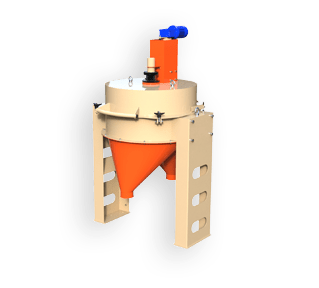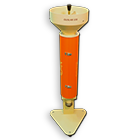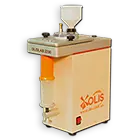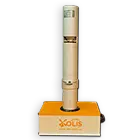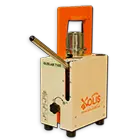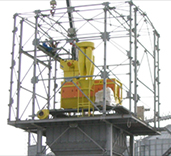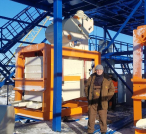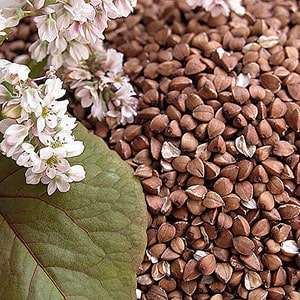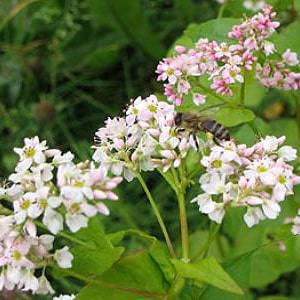Buckwheat has acquired a reputation as a finicky crop. This is due to the demands regarding the quality of the soil, temperature, humidity and other factors at different periods of plant development.
A feature of buckwheat is 6 stages of phenological development:
- Emergence of shoots.
- Formation of the first leaves.
- Branching and setting buds.
- Blossom.
- Formation of fruits.
- Ripening.
Depending on the variety, the speed of harvesting may vary. Early ripening varieties ripen within 70 days after germination, and some even earlier. Mid-ripening varieties need 70-90 days to complete their entire life cycle; late-ripening varieties ripen in more than 90 days.
Buckwheat at different stages has different strengths and weaknesses. For example, a high level of humidity is not required for the emergence of seedlings, since a moisture level of 25 mm is sufficient in arable land. During the development period, plants require more and more water – during the period of active growth, the moisture level in the soil is required from 50 mm, and during the flowering period – at least 60-70 mm.
During the period of fruit formation, the need for water doubles. During flowering and fruit formation, buckwheat consumes half of all the moisture that the plant needs throughout its entire life cycle.
Therefore, growing buckwheat on the territory of Ukraine is not recommended in all areas, but only where sufficient precipitation is expected.
Moisture retention in the buckwheat growing area is possible in different ways, in particular by forest belts. It is in the fields next to which there are plantings of this kind that it is recommended to sow buckwheat.
The second important factor is temperature. For buckwheat seeds to ripen, the total active temperature (exceeding 10 degrees Celsius) should be 1300-1600 degrees. Warm and moderately humid weather during the flowering period is especially important.
If the temperature drops below 13 degrees at this time, the plant is not able to produce nectar and attract pollinating insects. The optimal temperature range is from 18 to 25 degrees. In this case, practically no plants will compete with buckwheat in terms of the amount of nectar, and the pollination process will occur as efficiently as possible.
If temperatures are too high and there is no moisture in the soil, the nectar simply evaporates, and insects, unable to benefit from the flowers, will lose interest in buckwheat crops. This will definitely affect the yield. Even self-pollinating varieties demonstrate a significant increase in yield, provided that apiaries are located near the fields, from which bees work on buckwheat crops during the flowering period.
Each bush is capable of a long flowering period. Flowers (over the entire growing season, up to 2000 of them can appear on one plant) and fruits are located nearby. Only 5-10% of the grains of the total number of ovaries will ripen, the rest of the fruits will fall off. The better conditions are provided in the fields (fertile soils, absence of pests and diseases, atmospheric disasters), the higher the percentage of fruits that will ripen.
Technology for sowing buckwheat in Ukraine
The preferred area for growing crops is forest-steppe fields. This is important because the plant is sensitive to strong gusts of wind. The most suitable soils, light in structure, are located in the south and center of this zone; often, even significant fertilization of the fields before sowing is not required. But in the north and in the Polesie zone, for a good buckwheat harvest, the soil needs to be fertilized with organic matter.
The practice of growing buckwheat has not become widespread in the south of Ukraine, on irrigated soils. In this case, two crops can be harvested from one field per season, provided that early ripening varieties have been selected correctly.
How to choose a specific field for sowing a crop, taking into account crop rotation requirements?
Since buckwheat respects light, crumbly soils, ideal predecessors will be crops that loosen the soil when cultivating crops. Potatoes, beets and corn, which do not have common pests and diseases with buckwheat, will be good predecessors. Somewhat worse options are legumes, lupine and flax. Sunflower and winter wheat can be predecessors only after high-quality soil fertilization.
Buckwheat is able to resist weeds when the seedlings begin to branch. In this phase, it forms a continuous carpet and deprives small plants of other types of access to resources, in particular to sunlight.
Therefore, it is necessary to ensure that there are no weeds in the area before sowing, and the seedlings will not have to be treated with herbicides. Autumn preparation of the area for sowing includes stubble peeling and soil disking.
Disk depth depends on what weeds are present in the field:
- to combat annuals, it is enough to disk to a depth of 6-8 centimeters;
- perennial weeds with creeping rhizomes will suffer when disked to a depth of 10-12 centimeters;
- perennials with parous rhizomes – to a depth of 12-14 centimeters.
When the chopped rhizomes of perennials sprout, the field should be plowed with autumn plowing to the depth of the arable layer (from 18 to 25 centimeters depending on the type of soil).
Spring treatment includes early harrowing to preserve the maximum amount of moisture in the soil, as well as three cultivation treatments:
- after the first shoots of weeds appear to a depth of 10-12 centimeters;
- after two weeks – to a depth of 8-10 centimeters;
- before sowing – with a beet cultivator to a depth of 3-4 centimeters.
Fertilizing the soil before sowing buckwheat consists of three stages:
- In autumn, when preparing the field for spring sowing, phosphorus-potassium fertilizers are applied to the soil, taking into account the recommended standards N30-60, P45-60 and K30-60 kg/ha. Autumn fertilization is especially important for fields located in areas of low rainfall; they will have a better effect on yield than applying fertilizers in the spring during sowing.
- When sowing, P10 fertilizer or complex forms of fertilizers are applied.
- For wide-row crops, post-sowing foliar feeding with complex fertilizers, ideally in chelate form, is effective. The culture absorbs such nutrients practically without residue. Boron fertilizers for green leaves are also recommended for buckwheat, as they will increase the number of buds. The crop responds well to fertilizer, which includes molybdenum, zinc, manganese; on soils containing peat, copper will be an important component. Fertilizer consumption rates depend on whether fertilizers were applied at previous stages. If no fertilizer was applied during sowing, the consumption of complex fertilizers will be 20-30 kg/ha. Chelated fertilizers are applied at the rate of 1-2 kg/ha. Post-sowing fertilizing is carried out twice – at the time of bud formation and at the time of active flowering.
Fertilizer consumption rates are influenced by which crop was the predecessor. Potatoes, beets, and corn are not able to take all the nutrients from the soil that are added as organic fertilizers, and legumes, thanks to symbiont microorganisms, contribute to the absorption of nitrogen from the air. Therefore, in fields where such predecessors grew, the rate of fertilizer consumption should be reduced by approximately one and a half times.
One of the most effective ways to apply combined fertilizer is to use wheat straw and beet tops. For better mineralization and active transformation processes, 8-12 kilograms of nitrogen fertilizers need to be applied per 1 ton of plant organic matter.
You need to remember which fertilizers can lead to negative consequences. We are talking about chlorine-containing preparations. If they need to be added, do it in the fall during fall plowing. Buckwheat has a pronounced reaction to chlorine – the leaves begin to turn red and dry out, this affects the yield. Therefore, it is preferable to choose chlorine-free potassium fertilizers for this crop.
How to choose a sowing scheme?
The highest yields can be obtained with wide-row sowing, when the row spacing is 45 cm. But this scheme should be used in cases where it is possible to treat the crops against weeds with a cultivator, and mechanical treatment should be carried out three times, the last time – during the flowering period. If this is not possible, it is enough to compact the crops and the closed bushes themselves will take care of the destruction of weed seedlings.
During the period when the first leaf appears, it is advisable to harrow compacted crops across the rows or at an angle to them. This will help control weeds and make the bud lighter. After the bushes are closed, there is no need to perform any mechanical tillage.
With wide-row sowing, seed consumption (in pieces) is 1.5-2.5 million/ha, with compacted sowing – 3-3.5 million/ha, and in some cases up to 5 are sown million/ha. On light soils, the depth of embedding is up to 5 cm, and on heavy soils – 2-3 cm.
How to choose and how to treat the seed mat?
The following varieties of buckwheat are common in Ukraine:
- “Agidel”;
- “Fragrance”;
- “Ballad”;
- “Bogatyr”;
- “Nine”;
- “Demeter”;
- “Dialogue”;
- “Dikul”;
- “Rain”;
- “Emerald”;
- “Inzerskaya”;
- “Kazanka”;
- “Natasha”;
- “Nectary”;
- “Svetlana”;
- “Saulyk”;
- “Cheremshanka”;
- “Four-Dau”;
- Chishkhinskaya.
“Nine” and “Dikul” gained the greatest popularity due to the following qualities:
- the ability to absorb the maximum amount of fertilizer, which affects the yield;
- quality of the kernel (pleasant taste and large buckwheat);
- self-pollinating (at the same time, the flowers of this variety are capable of being pollinated by bees, which makes it possible to obtain honey and increase the yield).
In Ukraine, farmers have recently begun to sow genetically transformed buckwheat, for example, the Canadian variety Granby. This variety is resistant to pests, and most importantly, it is able to produce a harvest 65 days after germination.
Thanks to this, you can navigate according to weather forecasters and sow buckwheat taking into account their recommendations, because frost damages the root system, and when the soil warms up to 50 degrees, the plant sheds buds and fruits.
Pre-sowing preparation of buckwheat includes treatment with growth stimulants. The responsiveness of buckwheat to mineral fertilizers was noticed many centuries ago, when people sifted the ash, moistened the seed mat with water or whey, and mixed the kernels with the ash. Now this function is performed by special preparations containing boric acid and ammonium molybdate, copper, zinc and iron chelates. This will increase the viability of the seedlings and allow the branches of the bushes to close faster, leaving no chance for the weeds to obtain vital resources.
In addition to fertilizers, seeds are also treated with dressing agents, which avoids significant damage to young crops by insect pests.
Sowing dates
Buckwheat is a heat-loving plant, so it is sown when the average daily temperature is 12-15 degrees. Such weather conditions are typical for May. For crops, a drop in temperature below 8 degrees Celsius is stressful.If the crops are designed to collect honey, then reseeding is carried out at intervals of 10-15 days, which will extend the flowering period.
Ultra-early ripening varieties and hybrids can be sown in the summer (June-July), as they will have time to produce a harvest. The short development period allows you to sow buckwheat taking into account the forecast of weather forecasters. The culture is also responsive to large amounts of sunlight – the longer the day, the more actively the plant develops. This is another argument in favor of summer sowing.
Which weeds are buckwheat ready to conquer, and which ones threaten the harvest?
Summer residents are advised to sow buckwheat on soils clogged with annuals, since densely sown buckwheat successfully displaces annuals. But with such competition you will not get a harvest.
Buckwheat needs weed control. The mechanical method of weed control is described above (this is cultivation, disking, harrowing). Without support from farmers, buckwheat can independently destroy up to 30% of annual weeds. The remainder will be a factor in reducing yields.
With repeated mechanical treatments in wide-row crops, up to 85% of annual weeds die. But it will not be possible to remove perennials so easily. For overly weeded fields, there are ways to destroy weeds using herbicides.
Perennial weeds (wheatgrass and sow thistle) are considered the greatest evil. They are destroyed in two stages – during pre-sowing preparation and during the period of active growth of buckwheat.
During the pre-sowing period, perennials are destroyed with herbicides, the main active component of which is the isopropylamine salt of glyphosate. These are “Hurricane”, “Glyfogan”, “Roundup” and others. The drug is applied to greening weed shoots before disking, cultivation or other work with the soil. During the period of treatment with herbicide, the height of wheatgrass should be 10-20 centimeters.
Discing or soil cultivation can be carried out no earlier than 15 days after applying the herbicide.Wheatgrass can also be destroyed during the period of active growth of buckwheat – preparations such as Targa Super and Fusilade Super are used to treat crops. Perennials cannot be destroyed by this treatment, but they will not actively develop, which will allow buckwheat to close over the weeds.
Annual cereals and dicotyledons are rarely able to adequately compete with buckwheat. But even among them there are their champions, whose growth dynamics allow them to take a place in the sun on the buckwheat field. These are acorn grass, wild radish, chicken millet, and blue bristleweed (better known as mice).
To combat them, pre-emergence herbicides are used, for example, “Dual Gold”, “Desormon”, “Luzaran”. After sowing of buckwheat, solutions of these preparations are applied to the soil, creating obstacles to the emergence of weeds.
This is especially important when sowing in spring, since weeds are able to develop at lower temperatures than buckwheat, and only a pre-emergence herbicide can prevent weeding of areas before buckwheat emerges.
In the period before the start of the budding phase, the crops can also be treated with post-emergence herbicides – “Targa Forte”, “Targa Super”, “Fusilad Super”. The same drugs are also used to control perennial weeds, but for perennials with a developed root system, a completely different concentration of herbicide is used. To combat ragwort and bitterweed, preparations containing prometrin are used.
Diseases and pests of buckwheat
Buckwheat is quite resistant to most diseases. But if the crops are weakened, they can be affected by various types of rot and spotting, ramularia, and downy mildew. The denser the plants are, the easier it will be for pathogens to spread.
With many diseases, plants become sterile and drop both flowers and fruits. Therefore, it is important to choose disease-resistant varieties and create conditions for the formation of healthy plants. When rot appears, the crops are treated with a 1% solution of Bordeaux mixture, and when powdery mildew appears, sulfur is sprayed on the field.
About 50 insect pests are ready to feed on different parts of buckwheat, but only a few can cause significant damage to the crop:
- buckwheat weevil;
- buckwheat flea;
- buckwheat psyllid;
- wheat scoop;
- aphids;
- wireworm;
- kravchik.
They can be successfully combated by mandatory autumn plowing, pre-sowing seed treatment and insecticidal preparations during the active growing season of buckwheat.
From this article you learned information about how to properly grow buckwheat and get a good harvest. Now you need to find out what equipment for buckwheat processing if you need it, please contact the experienced specialists of the Olis company.


